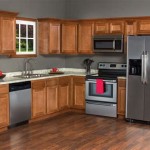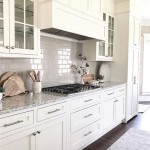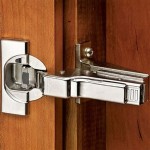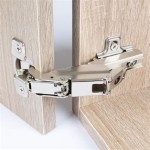How to Clean Black Gloss Kitchen Cabinets
Black gloss kitchen cabinets offer a sleek, modern aesthetic to any kitchen. However, their glossy surface readily reveals fingerprints, dust, grease, and water spots, requiring regular and proper cleaning to maintain their pristine appearance. Neglecting the cleaning process or using harsh chemicals can lead to scratches, dullness, and permanent damage to the finish.
This article provides a comprehensive guide on effectively cleaning black gloss kitchen cabinets, detailing necessary supplies, step-by-step instructions, and preventative measures to keep them looking their best. The intention is to equip individuals with the knowledge and techniques to maintain their cabinets without causing damage.
The Essentials: Gathering Your Cleaning Supplies
Before commencing the cleaning process, it is crucial to gather the necessary supplies. Using the appropriate materials ensures effective cleaning and minimizes the risk of damage to the delicate gloss finish. The following items are recommended:
Microfiber Cloths: These cloths are essential for cleaning gloss cabinets due to their soft, non-abrasive nature. Microfiber cloths effectively lift dirt and grime without scratching the surface. Invest in several high-quality cloths to avoid reintroducing dirt during the cleaning process. It is advisable to have separate cloths for washing and drying.
Warm Water: Warm water is a fundamental component of the cleaning solution. It helps to loosen dirt and grease without the need for harsh chemicals. Ensure the water is not too hot, as excessive heat can potentially damage the cabinet finish.
Mild Dish Soap: A small amount of mild dish soap can be added to the warm water to enhance its cleaning power. Select a dish soap that is gentle and free from abrasive ingredients. Avoid soaps with strong fragrances or dyes, as these can leave residue on the cabinets.
White Vinegar (Optional): White vinegar is a natural cleaning agent that can be used to remove stubborn grease and grime. Its acidic properties help to dissolve buildup without damaging the finish. However, it is important to dilute the vinegar with water to prevent it from being too harsh. A solution of one part white vinegar to two parts water is generally recommended.
Spray Bottle: A spray bottle is useful for applying the cleaning solution evenly to the cabinet surfaces. Choose a bottle that produces a fine mist to avoid oversaturating the wood. The spray bottle should be clean and free of any residual chemicals.
Soft-Bristled Brush (Optional): A soft-bristled brush can be used to gently scrub hard-to-reach areas or remove stubborn stains. Ensure the brush has soft bristles to avoid scratching the gloss finish. A toothbrush or a specialized cleaning brush designed for delicate surfaces are suitable options.
Bucket or Bowl: A bucket or bowl is necessary for mixing the cleaning solution. Choose a container that is clean and large enough to hold the desired amount of water and soap or vinegar.
Step-by-Step Guide to Cleaning Black Gloss Kitchen Cabinets
Once the cleaning supplies have been gathered, the following steps should be followed to effectively clean black gloss kitchen cabinets:
Dust the Cabinets: Begin by dusting the cabinets with a clean, dry microfiber cloth. This removes loose dirt and debris, preventing it from scratching the surface during the washing process. Pay particular attention to corners, edges, and decorative details where dust tends to accumulate. Regular dusting helps to maintain the shine and prevent buildup.
Prepare the Cleaning Solution: In a bucket or bowl, mix warm water with a small amount of mild dish soap. Alternatively, if using white vinegar, mix one part white vinegar with two parts warm water. Stir the solution gently to combine the ingredients, avoiding the creation of excessive suds. Test the cleaning solution on an inconspicuous area of the cabinet to ensure it does not cause any damage or discoloration. This is a precautionary measure that is crucial to protect the finish of the cabinets.
Apply the Cleaning Solution: Lightly dampen a clean microfiber cloth with the cleaning solution. Wring out any excess liquid to prevent oversaturation. Gently wipe down the cabinet surfaces, working in small sections. Use a soft-bristled brush to scrub any stubborn stains or hard-to-reach areas. Avoid applying excessive pressure, as this can scratch the finish. The goal is to lift the dirt and grime without damaging the underlying surface.
Rinse the Cabinets: After washing the cabinets, rinse them with a clean, damp microfiber cloth. Use fresh, warm water to remove any soap residue. It is important to remove all traces of soap, as it can leave a dull film on the cabinets. Wring out the cloth frequently to ensure it is clean and free of soap residue. Rinse the cloth thoroughly between each wipe.
Dry the Cabinets: Immediately dry the cabinets with a clean, dry microfiber cloth. Drying the cabinets prevents water spots and streaks from forming on the gloss finish. Use a gentle, circular motion to buff the surface and restore its shine. Ensure the cabinets are completely dry to prevent moisture damage. Using a high-quality microfiber cloth helps to achieve a streak-free finish.
Address Stubborn Stains: For stubborn stains that do not come off with the initial cleaning, consider using a specialized cabinet cleaner designed for gloss finishes. Follow the manufacturer's instructions carefully and test the cleaner on an inconspicuous area before applying it to the entire surface. Alternatively, a paste made from baking soda and water can be used to gently scrub the stain. Rinse the area thoroughly after applying the paste. Exercise caution when using abrasive cleaners, as they can easily damage the gloss finish.
Preventative Measures for Maintaining Black Gloss Kitchen Cabinets
In addition to regular cleaning, implementing preventative measures can help to maintain the appearance of black gloss kitchen cabinets and reduce the frequency of deep cleaning. These measures involve adopting mindful practices and employing protective strategies.
Wipe Up Spills Immediately: Promptly wipe up spills and splatters to prevent them from drying and becoming difficult to remove. Use a clean, damp microfiber cloth to absorb the spill and then dry the area thoroughly. Addressing spills immediately prevents staining and damage to the cabinet finish.
Use Placemats and Coasters: Protect cabinet surfaces from heat, moisture, and scratches by using placemats and coasters. Placing hot dishes and drinks directly on the cabinets can cause damage to the gloss finish. Placemats and coasters provide a barrier between the cabinets and potential damaging agents.
Ventilate the Kitchen: Ensure proper ventilation in the kitchen to reduce the buildup of grease and moisture. Use the exhaust fan when cooking to remove steam and odors. Open windows and doors to allow fresh air to circulate. Proper ventilation helps to prevent the formation of a sticky film on the cabinets.
Avoid Harsh Chemicals and Abrasive Cleaners: Refrain from using harsh chemicals, abrasive cleaners, and scouring pads, as these can scratch and dull the gloss finish. Stick to mild cleaning solutions and soft microfiber cloths. Avoid cleaners containing ammonia, bleach, or strong solvents. Always test new cleaning products on an inconspicuous area before applying them to the entire surface.
Regular Dusting: Dust the cabinets regularly with a clean, dry microfiber cloth to remove loose dirt and debris. This prevents the buildup of dirt and makes the cleaning process easier. Pay particular attention to areas that are prone to dust accumulation, such as corners and edges. Regular dusting helps to maintain the shine and appearance of the cabinets.
Apply a Protective Polish: Consider applying a specialized cabinet polish designed for gloss finishes to protect the cabinets and enhance their shine. Follow the manufacturer's instructions carefully and test the polish on an inconspicuous area before applying it to the entire surface. Polish can help to create a barrier against dirt and grime and make the cabinets easier to clean. Choose a polish that is specifically formulated for gloss finishes to avoid damaging the surface.
By following these guidelines, individuals can effectively clean and maintain their black gloss kitchen cabinets, ensuring they retain their sleek, modern appearance for years to come. The key is to use gentle cleaning methods, appropriate supplies, and proactive preventative measures. Regular care and attention will help to keep these high-shine surfaces looking their best.

How To Clean High Gloss Kitchen Units

The Best Way To Clean A High Gloss Surface

Looking After Your New Replacement Kitchen Doors Door Work

The Best Way To Clean A High Gloss Surface

How To Clean Gloss Kitchen Doors Blog Warehouse

How To Clean High Gloss Kitchen Units Properly

Cleaning Mrs Hinch Fans Share Best Tips To Spruce Up Kitchen Cupboards Express Co

High Gloss Kitchen Cabinets Design By Primehardware Inc

How To Clean High Gloss Kitchen Units Properly

How To Clean High Gloss Kitchen Units Properly
Related Posts








